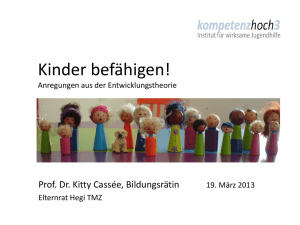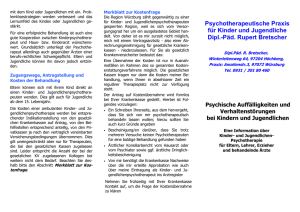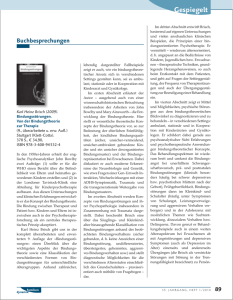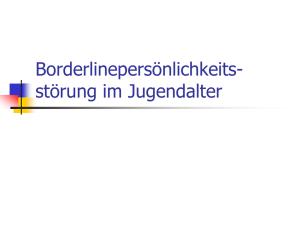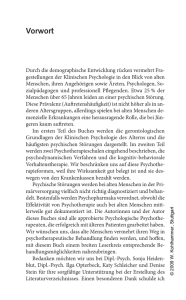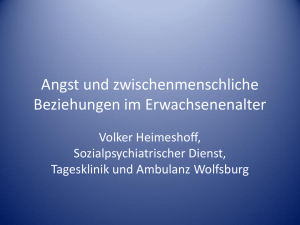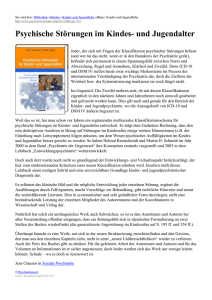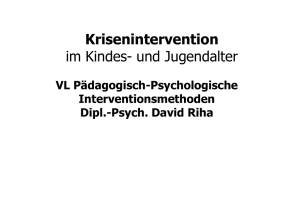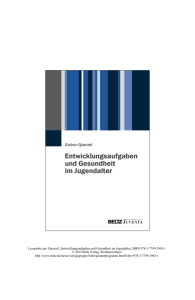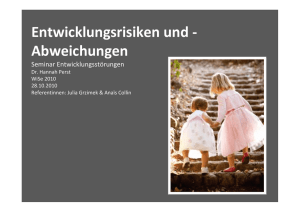Inhalt - Kohlhammer
Werbung
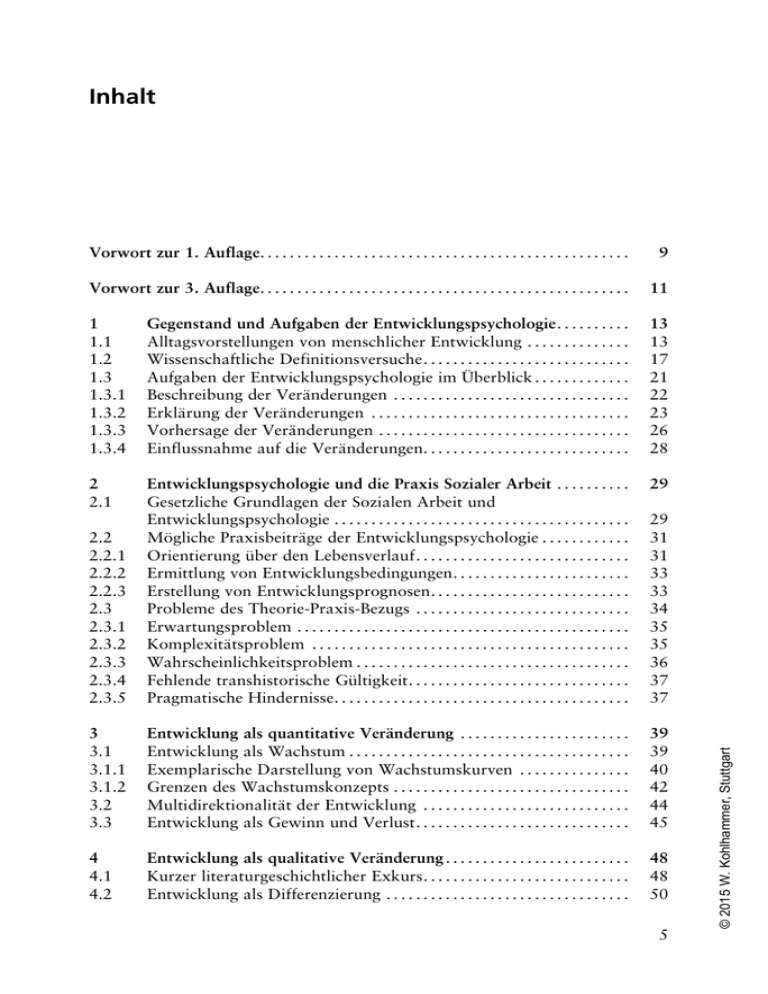
Vorwort zur 1. Auflage. . . . . . . . . . . . . . . . . . . . . . . . . . . . . . . . . . . . . . . . . . . . . . . . . . 9 Vorwort zur 3. Auflage. . . . . . . . . . . . . . . . . . . . . . . . . . . . . . . . . . . . . . . . . . . . . . . . . . 11 1 1.1 1.2 1.3 1.3.1 1.3.2 1.3.3 1.3.4 Gegenstand und Aufgaben der Entwicklungspsychologie. . . . . . . . . . Alltagsvorstellungen von menschlicher Entwicklung . . . . . . . . . . . . . . Wissenschaftliche Definitionsversuche. . . . . . . . . . . . . . . . . . . . . . . . . . . . Aufgaben der Entwicklungspsychologie im Überblick . . . . . . . . . . . . . Beschreibung der Veränderungen . . . . . . . . . . . . . . . . . . . . . . . . . . . . . . . . Erklärung der Veränderungen . . . . . . . . . . . . . . . . . . . . . . . . . . . . . . . . . . . Vorhersage der Veränderungen . . . . . . . . . . . . . . . . . . . . . . . . . . . . . . . . . . Einflussnahme auf die Veränderungen. . . . . . . . . . . . . . . . . . . . . . . . . . . . 13 13 17 21 22 23 26 28 2 2.1 29 2.2 2.2.1 2.2.2 2.2.3 2.3 2.3.1 2.3.2 2.3.3 2.3.4 2.3.5 Entwicklungspsychologie und die Praxis Sozialer Arbeit . . . . . . . . . . Gesetzliche Grundlagen der Sozialen Arbeit und Entwicklungspsychologie . . . . . . . . . . . . . . . . . . . . . . . . . . . . . . . . . . . . . . . . Mögliche Praxisbeiträge der Entwicklungspsychologie . . . . . . . . . . . . Orientierung über den Lebensverlauf. . . . . . . . . . . . . . . . . . . . . . . . . . . . . Ermittlung von Entwicklungsbedingungen. . . . . . . . . . . . . . . . . . . . . . . . Erstellung von Entwicklungsprognosen. . . . . . . . . . . . . . . . . . . . . . . . . . . Probleme des Theorie-Praxis-Bezugs . . . . . . . . . . . . . . . . . . . . . . . . . . . . . Erwartungsproblem . . . . . . . . . . . . . . . . . . . . . . . . . . . . . . . . . . . . . . . . . . . . . Komplexitätsproblem . . . . . . . . . . . . . . . . . . . . . . . . . . . . . . . . . . . . . . . . . . . Wahrscheinlichkeitsproblem . . . . . . . . . . . . . . . . . . . . . . . . . . . . . . . . . . . . . Fehlende transhistorische Gültigkeit. . . . . . . . . . . . . . . . . . . . . . . . . . . . . . Pragmatische Hindernisse. . . . . . . . . . . . . . . . . . . . . . . . . . . . . . . . . . . . . . . . 29 31 31 33 33 34 35 35 36 37 37 3 3.1 3.1.1 3.1.2 3.2 3.3 Entwicklung als quantitative Veränderung . . . . . . . . . . . . . . . . . . . . . . . Entwicklung als Wachstum . . . . . . . . . . . . . . . . . . . . . . . . . . . . . . . . . . . . . . Exemplarische Darstellung von Wachstumskurven . . . . . . . . . . . . . . . Grenzen des Wachstumskonzepts . . . . . . . . . . . . . . . . . . . . . . . . . . . . . . . . Multidirektionalität der Entwicklung . . . . . . . . . . . . . . . . . . . . . . . . . . . . Entwicklung als Gewinn und Verlust. . . . . . . . . . . . . . . . . . . . . . . . . . . . . 39 39 40 42 44 45 4 4.1 4.2 Entwicklung als qualitative Veränderung . . . . . . . . . . . . . . . . . . . . . . . . . Kurzer literaturgeschichtlicher Exkurs. . . . . . . . . . . . . . . . . . . . . . . . . . . . Entwicklung als Differenzierung . . . . . . . . . . . . . . . . . . . . . . . . . . . . . . . . . 48 48 50 5 © 2015 W. Kohlhammer, Stuttgart Inhalt Inhalt 4.2.1 4.2.2 4.3 4.3.1 4.3.2 4.3.3 4.3.4 4.4 4.4.1 4.4.2 4.4.3 Exemplarische Darstellung von Differenzierungsprozessen . . . . . . . . . Entwicklung als Differenzierung des Lebensraums. . . . . . . . . . . . . . . . . Kognitive Entwicklung als qualitativer Entwicklungsprozess . . . . . . . Stadium der sensomotorischen Intelligenz . . . . . . . . . . . . . . . . . . . . . . . . . Voroperationales Denken . . . . . . . . . . . . . . . . . . . . . . . . . . . . . . . . . . . . . . . . Stadium der konkreten Operationen . . . . . . . . . . . . . . . . . . . . . . . . . . . . . . Stadium der formalen Operationen . . . . . . . . . . . . . . . . . . . . . . . . . . . . . . . Moralische Entwicklung als qualitativer Entwicklungsprozess . . . . . Einführende Überlegungen . . . . . . . . . . . . . . . . . . . . . . . . . . . . . . . . . . . . . . . Die Entwicklung des moralischen Urteils (Piaget). . . . . . . . . . . . . . . . . . Die Moralentwicklung nach Kohlberg . . . . . . . . . . . . . . . . . . . . . . . . . . . . 5 5.3.5 Beschreibung der Entwicklung in umfassenden Entwicklungsmodellen . . . . . . . . . . . . . . . . . . . . . . . . . . . . . . . . . . . . . . . . . . . Entwicklung als Triebentwicklung (Freud) . . . . . . . . . . . . . . . . . . . . . . . . Aufbau der Persönlichkeit aus psychoanalytischer Sicht . . . . . . . . . . . Triebtheorie der Psychoanalyse . . . . . . . . . . . . . . . . . . . . . . . . . . . . . . . . . . . Psychoanalytisches Entwicklungsmodell . . . . . . . . . . . . . . . . . . . . . . . . . . Kritik des psychoanalytischen Entwicklungsmodells . . . . . . . . . . . . . . . Entwicklung als Bewältigung psychosozialer Krisen (Erikson) . . . . . Ausgangsüberlegungen . . . . . . . . . . . . . . . . . . . . . . . . . . . . . . . . . . . . . . . . . . . Beschreibung der Entwicklungsstufen . . . . . . . . . . . . . . . . . . . . . . . . . . . . . Kritik des Entwicklungsmodells von Erikson . . . . . . . . . . . . . . . . . . . . . . Entwicklung als Lösung von Entwicklungsaufgaben (Havighurst) . . Quellen der Entwicklungsaufgaben . . . . . . . . . . . . . . . . . . . . . . . . . . . . . . . Charakteristika der Entwicklungsaufgaben. . . . . . . . . . . . . . . . . . . . . . . . Entwicklungsaufgaben im Überblick . . . . . . . . . . . . . . . . . . . . . . . . . . . . . . Exkurs: Entwicklungsaufgaben des Jugendalters und ihre Bewältigung . . . . . . . . . . . . . . . . . . . . . . . . . . . . . . . . . . . . . . . . . . . . . . . . . . . . . Kritik des Entwicklungsmodells von Havighurst . . . . . . . . . . . . . . . . . . 101 107 6 6.1 6.2 6.3 6.4 Grundlegende Denkrichtungen in der Entwicklungspsychologie. . . . Endogenistische Theorien . . . . . . . . . . . . . . . . . . . . . . . . . . . . . . . . . . . . . . . . Exogenistische Theorien. . . . . . . . . . . . . . . . . . . . . . . . . . . . . . . . . . . . . . . . . . Konstruktivistische Theorien . . . . . . . . . . . . . . . . . . . . . . . . . . . . . . . . . . . . . Interaktionistische Theorien . . . . . . . . . . . . . . . . . . . . . . . . . . . . . . . . . . . . . . 108 109 111 113 114 7 7.1 7.1.1 7.1.2 7.2 7.3 7.3.1 7.3.2 7.4 Einflussfaktoren in der Entwicklung . . . . . . . . . . . . . . . . . . . . . . . . . . . . . . Genetische Einflussfaktoren und Entwicklung . . . . . . . . . . . . . . . . . . . . . Allgemeine Vorüberlegungen . . . . . . . . . . . . . . . . . . . . . . . . . . . . . . . . . . . . . Genetischer Einfluss auf die Entwicklung der Persönlichkeit . . . . . . . Reifungsprozesse und Entwicklung . . . . . . . . . . . . . . . . . . . . . . . . . . . . . . . Lernen und Entwicklung . . . . . . . . . . . . . . . . . . . . . . . . . . . . . . . . . . . . . . . . . Klassisches Konditionieren . . . . . . . . . . . . . . . . . . . . . . . . . . . . . . . . . . . . . . . Operantes Konditionieren . . . . . . . . . . . . . . . . . . . . . . . . . . . . . . . . . . . . . . . . Selbststeuerung der Entwicklung. . . . . . . . . . . . . . . . . . . . . . . . . . . . . . . . . . 117 117 117 120 123 126 127 129 138 6 77 77 77 80 81 87 88 88 89 96 97 97 97 99 © 2015 W. Kohlhammer, Stuttgart 5.1 5.1.1 5.1.2 5.1.3 5.1.4 5.2 5.2.1 5.2.2 5.2.3 5.3 5.3.1 5.3.2 5.3.3 5.3.4 50 51 53 54 57 61 63 64 64 65 68 Inhalt 7.4.1 7.4.2 7.4.3 7.4.4 8 8.1 8.1.1 8.1.2 8.1.3 8.2 8.2.1 8.2.2 8.3 8.4 8.4.1 8.4.2 8.4.3 8.5 9 9.1 9.2 9.3 9.4 9.4.1 9.4.2 9.4.3 9.5 9.6 Selbststeuerung der Entwicklung durch primäre und sekundäre Kontrolle . . . . . . . . . . . . . . . . . . . . . . . . . . . . . . . . . . . . . . . . . . . . . . . . . . . . . . . Selbststeuerung der Entwicklung durch Selektivität und Kompensation. . . . . . . . . . . . . . . . . . . . . . . . . . . . . . . . . . . . . . . . . . . . . . . . . . . Optimierung der Selbststeuerung der Entwicklung . . . . . . . . . . . . . . . . Selbststeuerung der Entwicklung und Soziale Arbeit . . . . . . . . . . . . . . 138 140 142 143 Sozial-emotionale Entwicklung in Kindheit und Jugendalter . . . . . . Bindungstheorie . . . . . . . . . . . . . . . . . . . . . . . . . . . . . . . . . . . . . . . . . . . . . . . . . Die Bindungstheorie und ihre historischen Ursprünge . . . . . . . . . . . . . Zentrale Konzepte der Bindungstheorie . . . . . . . . . . . . . . . . . . . . . . . . . . Konzepte der kindlichen Bindungsqualität. . . . . . . . . . . . . . . . . . . . . . . . Bindungsstörungen . . . . . . . . . . . . . . . . . . . . . . . . . . . . . . . . . . . . . . . . . . . . . . Klinische Beschreibung der beiden Formen von Bindungsstörungen Intervention bei Kindern mit Bindungsstörungen . . . . . . . . . . . . . . . . . Kritische Reflexion der Bindungstheorie. . . . . . . . . . . . . . . . . . . . . . . . . . Sozial-emotionale Entwicklungen im Kindes- und Jugendalter. . . . . Vier Perspektiven auf die Entstehung und Bedeutung von Emotionen . . . . . . . . . . . . . . . . . . . . . . . . . . . . . . . . . . . . . . . . . . . . . . . . . . . . . . Sozial-Emotionale Störungen im Kindes- und Jugendalter . . . . . . . . . Risiko- und Schutzfaktoren zur Ausbildung einer sozialemotionalen Störung . . . . . . . . . . . . . . . . . . . . . . . . . . . . . . . . . . . . . . . . . . . . Emotionale Kompetenz nach Saarni als Rahmenmodell der Förderung. . . . . . . . . . . . . . . . . . . . . . . . . . . . . . . . . . . . . . . . . . . . . . . . . . . 165 Entwicklungsprognosen und praktisches Handeln . . . . . . . . . . . . . . . . Entwicklungsprognosen in der Sozialen Arbeit . . . . . . . . . . . . . . . . . . . Grundlagen von Entwicklungsprognosen . . . . . . . . . . . . . . . . . . . . . . . . . Bedingungsorientierte Entwicklungsprognosen . . . . . . . . . . . . . . . . . . . Merkmalsorientierte Prognosen . . . . . . . . . . . . . . . . . . . . . . . . . . . . . . . . . . Stabilitätsdaten als Grundlage von Prognosen . . . . . . . . . . . . . . . . . . . . Frühzeitige Prognose von Entwicklungsauffälligkeiten . . . . . . . . . . . . Lebensalter und Treffsicherheit von Prognosen . . . . . . . . . . . . . . . . . . . Kombinierte Entwicklungsprognosen. . . . . . . . . . . . . . . . . . . . . . . . . . . . . Resilienz und Entwicklung. . . . . . . . . . . . . . . . . . . . . . . . . . . . . . . . . . . . . . . 168 168 170 171 175 175 179 183 184 186 156 158 162 10 190 190 190 192 194 195 7 © 2015 W. Kohlhammer, Stuttgart Das Trainingsprogramm zur Aggressionsminderung (TAV) als Beispiel für ein Interventionsprogramm bei delinquenten Jugendlichen . . . . . . . . . . . . . . . . . . . . . . . . . . . . . . . . . . . . . . . . . . . . . . . . . . . . 10.1 Aggressives Verhalten im Jugendalter als Problemlage . . . . . . . . . . . . 10.1.1 Erscheinungsformen und Häufigkeit aggressiven Verhaltens im Jugendalter . . . . . . . . . . . . . . . . . . . . . . . . . . . . . . . . . . . . . . . . . . . . . . . . . . 10.1.2 Mögliche Erklärungen aggressiven Verhaltens . . . . . . . . . . . . . . . . . . . . 10.1.3 Möglichkeiten der Prävention und Intervention bei aggressivem Verhalten . . . . . . . . . . . . . . . . . . . . . . . . . . . . . . . . . . . . . . . . . . . . . . . . . . . . . . . 10.2 Das Trainingsprogramm zur Aggressionsverminderung (TAV) . . . . 146 146 146 147 150 153 153 155 156 156 Inhalt 10.2.1 10.2.2 10.2.3 10.2.4 10.3 10.3.1 Ziele des Programms TAV . . . . . . . . . . . . . . . . . . . . . . . . . . . . . . . . . . . . . . . Programmbeschreibung und Methoden . . . . . . . . . . . . . . . . . . . . . . . . . . . Organisatorischer Ablauf des Programms . . . . . . . . . . . . . . . . . . . . . . . . . Rahmenbedingungen . . . . . . . . . . . . . . . . . . . . . . . . . . . . . . . . . . . . . . . . . . . . . Beschreibung der Stichprobe und ausgewählte Ergebnisse. . . . . . . . . . Kurzbeschreibung der Durchführung der Intervention und Kennzeichnung der Stichprobe. . . . . . . . . . . . . . . . . . . . . . . . . . . . . . . . . . . . 10.3.2 Methoden . . . . . . . . . . . . . . . . . . . . . . . . . . . . . . . . . . . . . . . . . . . . . . . . . . . . . . . 10.3.3 Darstellung ausgewählter Ergebnisse der Evaluation. . . . . . . . . . . . . . . 10.4 Diskussion der Ergebnisse . . . . . . . . . . . . . . . . . . . . . . . . . . . . . . . . . . . . . . . . 10.5 Fazit. . . . . . . . . . . . . . . . . . . . . . . . . . . . . . . . . . . . . . . . . . . . . . . . . . . . . . . . . . . . . 195 196 199 200 201 201 202 203 206 209 Literatur. . . . . . . . . . . . . . . . . . . . . . . . . . . . . . . . . . . . . . . . . . . . . . . . . . . . . . . . . . . . . . . . 210 8 © 2015 W. Kohlhammer, Stuttgart Stichwortverzeichnis . . . . . . . . . . . . . . . . . . . . . . . . . . . . . . . . . . . . . . . . . . . . . . . . . . . . 225
